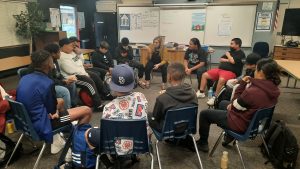CDE grant will equip thirteen schools to provide expanded wrap-around supports that affirm the district’s commitment to caring for the whole child

The La Mesa-Spring Valley School District (LMSV) recently received significant affirmation of its efforts to engage its families thanks to a ‘Community Schools’ grant worth just over $17 million. The five-year grant was awarded by California’s State Department of Education (CDE) and is part of an ambitious initiative to turn thousands of state schools into ‘Community Schools’.
The funds will help LMSV provide wrap-around services for students and families that increase support beyond school instruction. Additional supports may include programs for parent education, mental health support, medical and dental care, after-school tutoring and intervention, attendance intervention and support, and more.
LMSV was awarded the grant to cover thirteen of its schools, beginning in the 2024 – 2025 school year. Each of the schools will be staffed with a Community Services Facilitator who will assist in planning and executing the new services and activities.

The CDE explains the initiative this way: “A community school is a public school that serves prekindergarten through grade twelve and has community partnerships that support improved academic outcomes, whole-child engagement, and family development. Community school partnership strategies include integrated supports services, extended learning time, and collaborative leadership and practices for educators and administrators.”
Hubs To Serve The Entire LMSV Community
Three of the schools will serve as centralized ‘hubs’ and each will be staffed with a parent liaison, clerical support, and a social worker. Parent education classes will take place at the hubs, as will the scheduled therapy sessions with students and families, as well as other medical services.
“The hubs will be like a one-stop-shop for all of our community family members,” says Jennifer Coronel, Director of Student Supports for LMSV. “The services at these sites will be available to all families in the district, even those from schools that did not get funded through Community Schools Grant.”
Coronel was instrumental in collecting and assembling the data to write the grant application, a process that took close to two years. The research project included collective input from school sites, parent communities, and focus groups at all of the schools included in the grant.
“We met with families, students, teachers, and administrators and sent out surveys,” explains Coronel. “We asked them all a series of questions, which really boiled down to ‘What does your ideal dream school look like?’”
Her team used the feedback to help create the grant application, which, says Coronel, was based around the four key pillars of the Community Schools Grant framework: integrated student supports; family and community engagement; collaborative leadership and practices for educators and administrators; and extended learning time and opportunities for students.
Expanded Opportunities for Support & Enrichment
“One of the big things that came out of the parent focus groups was that they want a safe place for their kids to be after school hours. So we’re really excited about building a place where families and students feel safe to come for longer periods of time other than the school day. It will essentially be a community hub for families to also get vaccines, make medical appointments, have individual or family counseling, pick up food, all of those things in one place.”
The grant will allow the district to expand its already impressing ESS (Extended School Services) programs by offering more opportunities for students than are currently offered. Those opportunities may include additional athletics, creative and performing arts opportunities, and STEAM learning.

Serving The Whole Child
Coronel says the district will be getting the hub sites ready over the summer and hopes to “hit the ground running in August or September. It’s really exciting that this grant supports everyone in an attempt to create that shared leadership and parent relationship between school and district.”
LMSV District Nurse, Elaine Pendoley works with Coronel to establish partnerships with community-based organizations to make the services possible. “Because we’ve been anticipating this implementation, we’ve been finding out who can help and what services they’ve got available. We’ve found that everybody really wants to participate and join and partner with us,” reveals Pendoley.
She also reflects on the grant’s core message that ‘Supporting students outside of the classroom helps them succeed inside the classroom’. “The awareness of the ‘whole child’ idea has become more well-known and popular,” she says. “Acknowledging that a child doesn’t live in isolation and that they’re part of a family, and a community. And if those aren’t thriving, they’re not going to be as successful as they possibly can be at school.
“But if we can support the students, their families, and the community they live in, we’re going to set them up for success in life and in school. The goal is always to get them to where they can get to live to their fullest potential.”
Community Schools and Hubs
The schools included in the Community Schools grant for La Mesa-Spring Valley Schools are:
Community Schools
Avondale Elementary, Bancroft Elementary, Casa de Oro Elementary, Highlands Elementary, Kempton Dual-Language Academy Elementary, La Mesa Dale Elementary, La Presa Elementary, Loma Elementary, Rancho Elementary, Rolando Elementary, Sweetwater Springs Elementary, Spring Valley Academy Middle School, and STEAM Academy Middle School.
Hub Schools
La Mesa Dale Elementary
Spring Valley Academy
STEAM Academy

